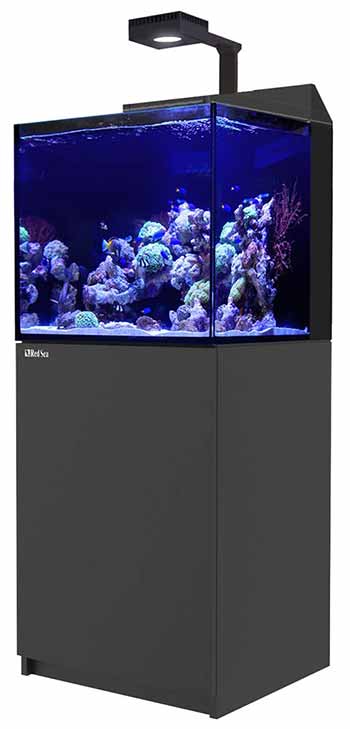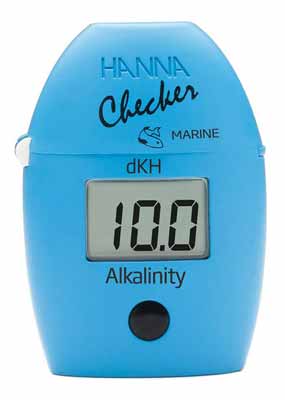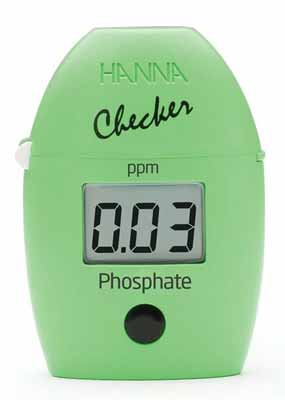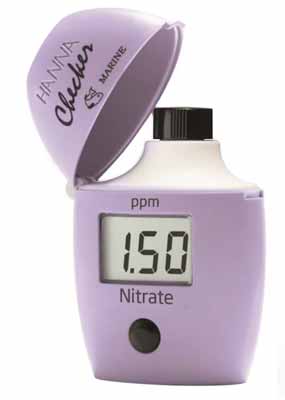Here at Reef Tank Resource, we would be remiss if we didn’t provide information about starting a new saltwater aquarium setup with marine fish only and live rock – no corals. Heresy you say? That’s no reef tank!
Not so fast buckaroo. Live rock is typically made up of coral, just not live coral. Semantics? Fair enough. But reef tanks typically start out as FOWLR (Fish Only With Live Rock) tanks prior to adding live corals. Also, a FOWLR saltwater aquarium is a great place to start as a beginner.
Additionally, it’s great for advanced reefers too. What’s nice about a FOWLR is you can keep saltwater fish in your aquarium that normally wouldn’t work with a reef tank. The rockscape can be quite attractive in and of itself.
This guide will provide information about a rock-solid saltwater FOWLR fish tank setup for beginners.
Let’s dive in.
New Saltwater Aquarium For Beginners - Setup Guide and Tips
What Size Saltwater Tank Should A Beginner Get?
A beginner should get a tank no smaller than 40 gallons. In smaller tanks, it is more difficult to maintain stable water parameters. The larger the tank the more stable it will be. The more stable the tank the easier it is to maintain water parameters in a healthy range.
Obviously bigger means more money. Not just for the aquarium but for all of the equipment as well. If your budget can handle a 125-gallon aquarium, like the one I have, you’ll find it very easy to have a thriving saltwater ecosystem.
You may be concerned that a larger aquarium will require more maintenance but you’d mostly be wrong. For instance, a 5-gallon aquarium needs attention every day. 20-gallon aquariums need attention every couple of days. 40-gallon tanks should be maintained at least weekly. My 125-gallon tank gets a water change every 2-weeks.
Don’t be tempted by those beautiful nano aquariums just yet. They are cheaper to set up but require a lot more attention due to their small water volume.
A nano saltwater aquarium can turn catastrophic quickly if you overfeed or something dies before you can discover and remove it.
When parameters such as ammonia, phosphates, or nitrates begin to spike they do so more rapidly and drastically in a smaller amount of water, which can more quickly harm or kill fish and corals.
The reason is that since the amount of water is so small, excess fish waste, uneaten food, and dead matter release toxic ammonia and nitrites into the small amount of water which doesn’t dilute it as easily. This can quickly make your saltwater tank deadly.
Larger saltwater aquariums have more water to dilute the fish waste, uneaten food, and dead matter. Choose as big a tank as you can for your first aquarium. For instance, I have a 125-gallon aquarium and I firmly believe that it would be a good first tank for most beginners to choose. It may seem counterintuitive but it is much easier to maintain if your budget can handle the added expense.
45 Gallon All-In-One Red Sea MAX E 170
If you’re interested in getting into the saltwater aquarium hobby, an All-In-One aquarium makes it as easy as possible. These AIO aquariums include almost everything you need. You just need to add sand, live rock, saltwater, and fish.
The Red Sea MAX E 170 is only 45 gallons (37 gallons in the main display tank and 8 gallons in the rear sump) but this is large enough that it will provide a stable volume of water.
This aquarium includes a powerful LED light capable of growing corals and can be controlled by an app on your phone. It also includes a rear sump that you can add filter media such as biological, carbon, or chemical media to help control.
What Is The Best Starter Saltwater Aquarium?
The best starter saltwater aquarium is an All-In-One (AIO) aquarium like the Red Sea MAX-E 170. The great thing about an AIO saltwater aquariums is that it takes all of the guesswork out of picking and sizing equipment. They contain everything you need to successfully maintain a FOWLR or reef tank easily.
There are many AIO tanks on the market and most are quite good. Red Sea is recognized as the most popular AIO manufacturer and for good reason. They do an excellent job of building rock-solid AIO saltwater tanks and speccing them out with quality equipment. It makes set up almost plug-and-play.
If I could give you one best tip it would be to start off with a Red Sea AIO aquarium. The Red Sea MAX-E 170 is an excellent choice and one that I’ve owned personally. It’s a great AIO in the 40-gallon tank range and has almost everything you need to get started short of salt water, live rock, and fish.
How Much Does It Cost To Set Up A Saltwater Fish Tank?
How much does it cost to start a saltwater tank? The total cost to set up a beginner saltwater fish tank properly will typically be $2500-$3000. This would include live rock, water, fish, an all-in-one aquarium like the Red Sea MAX-E 170, and a few miscellaneous bits and bobs such as a water heater, fish food, and thermometer.
This isn’t an inexpensive hobby for people to get into. It’s a big step beginning, but once you’ve made your initial investment the process and expense much more manageable. Ongoing maintenance costs are reasonable but occasionally you may need to replace a piece of equipment that may cost a couple of hundred dollars. Some people even keep backups of critical equipment such as return pumps and heaters in case of failure.
A new All-In-One aquarium is expensive but piecing together all of the components and totaling up their cost is likely going to be nearly as costly. A good-quality small AIO is going to cost over a thousand dollars and bigger ones can easily exceed a few thousand.
Saltwater fish are not inexpensive either. It’s not uncommon for fish to cost well over one hundred dollars although I’ve personally never spent that much. Most of the fish I’ve purchased have been fifty dollars or less.
Live Rock IS Your Saltwater Aquariums Filter
The common wisdom is to add 1 to 2 pounds of live rock per gallon but that doesn’t account for how porous your live rock is or how many saltwater fish you plan to keep. We could dive deep into live rock alone but that’s not what this article is about.
If you want to dive deeper you can read all about it in our article Live Rock & Dead Rock – Aquascaping, Coralline Algae, & How Much. We recommend aqua-cultured live rock which you can supplement with some dead rock. After some time, the micro-organisms from your aqua-cultured rock spread to your dead rock. Pukani or Fiji is great because it is very porous which means it’s able to contain more micro-organisms.
Saltwater Aquarium Flow
You need to make sure there is a good amount of water flowing in, around, and through your rocks in your new tank when starting out to allow the micro-organisms to process the waste in the tank. The first method of flow in your aquarium is your return pump, assuming you have a sump of some kind – either a traditional sump in your stand or an integrated sump in the back of the main aquarium.
How much flow should a FOWLR tank have? Most people will suggest a good minimum is to have your return pump turn over your main display tank volume 20 times per hour. Reef tanks require closer to 100 times per hour or more but a FOWLR doesn’t have as high demands due to the lack of sensitive corals.
A couple of powerheads are great at giving you any extra flow you’ll need. You don’t want to blow your fish around but a fairly strong current is a good thing. Powerheads are great for directing flow toward low-flow areas you see fish waste and other detritus accumulating on your sand bed.
The downsides of powerheads to increase the water flow through your tank is that they aren’t the most attractive and they are an added expense. Inexpensive powerheads can do a great job but tend to be larger and more difficult to place inconspicuously. Smaller and slimmer powerheads that can get the job done well tend to be a bit more expensive.
Additional Saltwater Aquarium filtration
Tank Hang On Filters
Hanging equipment onto your main aquarium detracts from the look of your fish and tank but is a good solution for some due to not being able to use a sump. Hang-on equipment also tends to be smaller and geared more toward smaller aquariums. It can definitely get the job done but often comes at the expense of flexibility and aesthetics.
Canister Filters
Canisters are useful because they hold a variety of media but require frequent cleaning. Many find canisters more trouble than they’re worth.
If you have a canister filter already it can be a great addition if you give it weekly cleanings. Also, since it usually can hold different types of filter media it can be a great tool for tackling specific problems. For instance, adding carbon can help clear up the yellowing of your water, or adding Phosban can help reduce phosphate levels thereby reducing algae problems.
Media Reactors
Very similar to canisters but much more focused. Reactors are equipment that is not designed to capture particulates but simply run water through a media like Carbon. They don’t require as frequent cleaning, typically just regular media changes.
Unlike canisters, there isn’t a pump within the reactor so an external pump is usually required. They also typically are designed for holding only one type of media at a time.
Many are designed only for one specific media. More generic reactors can hold granulated media of different types while there are many purpose-specific reactors such as macroalgae reactors, calcium reactors, and more.
Protein Skimmers
Probably the most popular filtration solution for a saltwater aquarium. Skimming equipment is designed to add micro-bubbles to the saltwater. Dissolved waste adheres to the bubbles and floats up to a collection cup. The cup of dissolved organics can then be tossed out during regular maintenance.
The appeal of protein skimmers is that they remove fish waste, uneaten food, and other decomposing organics before they have a chance to begin breaking down into harmful byproducts. This helps eliminate the potential problem before it occurs.
You’ll need to adjust the setting of the skimmer to not skim too wet or too dry. You want to adjust the setting to produce a thick goop but thin enough you can pour out. If it is too wet it will fill rapidly and not collect much waste. Too dry and it won’t collect fast enough and leave a lot of waste in your water. Once set correctly you’ll rarely need to adjust it.
Skimmers can be purchased as hang on types or in-sump types. There are even small skimmers designed to be mounted within smaller aquariums.
Macroalgae Refugiums
These primarily resolve algae problems in your tank. Phosphates from the process of saltwater fish waste breaking down are what algae feed on. A refugium contains easily manageable macroalgae, such as chaetomorpha, that feeds on the phosphates instead of algae in your tank. Like protein skimmers, they can be had as hang on or sump versions.
Aquarium Sumps
While not a filter, strictly speaking, it does house filtration devices. A sump is a separate smaller aquarium that typically sits underneath your main tank hidden in the stand. Water flows down to the sump and typically interacts with several filtration methods before being pumped back up to the main display tank. A common path through a sump would include:
- Overflow (which skims detritus from the water surface)
- Filter Socks
- Protein Skimmer
- Refugium
- Bio Media
- Return Pump
Depending on your circumstances you may not want to attempt a sump. They are highly recommended but not required. If you do think a sump is something you want to include you’ll want to prepare for it before purchasing any items. For more on sumps check out our Reef Tank Plumbing Guide – Designs, Diagrams, Sump, Overflow, Return to see what’s involved.
Bubble Magus BM-Curve 5 Protein Skimmer
Protein Skimmers are extremely popular methods of removing fish waste and uneaten food before it breaks down into harmful byproducts. It works by injecting bubbles into the water. If dissolved organics are in the water it will create a foam and rise to the collection cup. Simply dump the cup during regular maintenance to help maintain pristine water quality.
Marine Aquarium Lighting For Fish Only With Live Rock
Obviously, aquarium lighting is not as critical for a fish only with a live rock setup but it’s not unimportant. Proper lighting is still required for coralline algae growth.
Old-school metal halides would be overkill. Not to mention they are expensive to run. They also get very hot and airflow around the bulbs becomes important. You could even find that a chiller might be required to keep the water temperature where desired. Halides are only for reef tanks and quite honestly, not a popular option even for those these days with the ability of LEDs to achieve similar results for less money and no need to swap out light bulbs.
Fluorescents are a solid choice with T5 bulbs being the best option. You can use fluorescents to grow corals later if you think you’ll add them down the road. Bulbs still obviously need to be replaced from time to time but they are far less expensive than halide bulbs.
LED units are great for the ability to set the color to your personal preference and program ramp up and down cycles. LEDs are also an excellent choice for avoiding changing out light bulbs. LEDs are far and away my favorite option for lighting any type of aquarium. The ability to set intensity and color is amazing. You can program sunrise, sunset, and even lightning storms all from a setting in an app on your phone.
Kessil A360x
Kessil LED lights lead the market in LED aquarium lighting. Their ability to produce lights with a dense LED matrix allows their lights to mimic a single bulb extremely closely. This design virtually eliminates the disco ball effect of other LED lights as the water refracts the individual LEDs onto the sand bed.
Saltwater Aquarium Temperature 75-80 degrees
Next step, you will need to source a good heater for your tank. 3 to 5 watts per gallon is a good rule of thumb to shop for here. Heaters are notorious for failing. Like with all equipment in the saltwater aquarium hobby, having a backup is a good practice. One method for redundant heaters is to have 2 different heaters set to different temps. One as a primary duty heater and the other to kick in as a backup. This only helps in a situation when a heater fails in the “off” position though. To protect from failures in the “on” position you really need a reef controller or similar device. This way you can use its digital thermostat to control your heaters. Also, good reef controllers can monitor power consumption too so you can monitor both aspects of your heater incase the thermometer for the controller fails.
A cheap solution to choose for controlling heaters is the INKBIRD ITC 306A. I like this inexpensive heater controller and it’s a brilliant little gadget. It monitors temps and controls 2 separate heaters.
Also, get a couple of thermometers. At a minimum, I’d suggest an easily readable glass in-tank and a good digital thermometer. Don’t rely on your heater settings to be accurate.
How Do You Start A New Saltwater Tank – For Beginners?
Once you have all of your new aquarium equipment setup, have filled your tank with water, and added a sand substrate and live rock, you need to allow your tank to go through the natural nitrogen cycle. Don’t try to stock your aquarium with marine fish or corals until this step is complete. This bit of information is a critical part of the process.
Setting up a new saltwater tank correctly means you have to allow your tank to sit with the equipment running while filled with sand, live rock, and salt water for a couple of weeks. Schedule the lights to come on and turn off regularly and make sure pumps, skimmers, heaters, etc. are all working as they should.
It’s suggested to add a small amount of fish food to the aquarium daily during this period. The food will decompose in the aquarium and release ammonia. Bacteria will begin to grow in the live rock and eventually convert all of the ammonia and nitrite. Later bacteria will grow to process the nitrite into nitrate. After more time even the nitrate will be very low after bacteria has grown to digest it.
Once nitrate is down to less than 30ppm (parts per million) you can safely add fish. If you intend to add coral you will want nitrate levels between 0.5ppm and 3ppm. These are goal numbers but should be what you strive to maintain.
How To Make Salt Water For Your New Saltwater Tank
Many people purchase pre-mixed saltwater at their local fish store. This is certainly a simple approach and a reasonable way to go. Carrying jugs of water once a month can get tedious so many people consider a RO/DI filter to make their own fresh and saltwater. Use fresh water to account for evaporated water and saltwater for changing 10 – 20 percent of your display tanks’ water volume once per month.
Mix your saltwater to a specific gravity of between 1.021 to 1.026. For measuring the specific gravity (aka salinity) you’ll need a refractometer or similar device. Refractometers can sometimes but a little difficult to read but tend to be more accurate. There are also digital tools available to do the job like the Milwaukee Digital Salinity Refractometer. They aren’t cheap but a dream to use. The easiest to use and still the budget-friendly device is a hydrometer. A hydrometer isn’t the most accurate device but it will do the job and get you within the right range.
Reverse Osmosis Filter
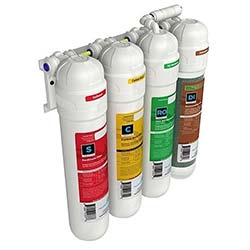
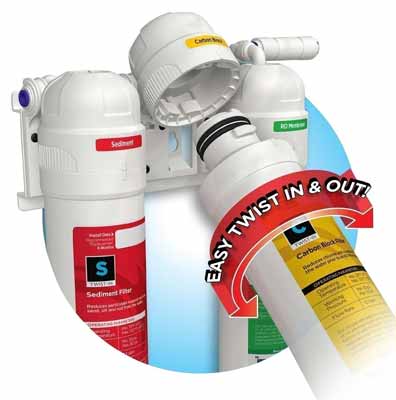
Tap water isn’t going to work for your saltwater aquarium. It has high phosphates which will cause algae blooms and also contains harsh chemicals like chlorine that aren’t good for fish or corals. A quality reverse osmosis filtration system can purify your tap water so you can mix your own saltwater at home.
Saltwater Aquarium Fish
As tempting as it may be to throw Nemo and Dory in your fish tank starting off on day one, you’ll need you cool your jets there slick. Give the tank a couple of weeks to stabilize before adding fish. You don’t want to wake up one morning to your prized fish swimming upside down.
Once your aquarium has finished the nitrogen cycle and is testing at zero for both ammonia and nitrite, it should be safe to begin adding fish, assuming your nitrate levels are below 10ppm. Reef aquariums should have 0.5 to 3ppm of nitrate detectable but higher levels are acceptable for FOWLR aquariums.
Start slow and with hardy saltwater fish. Many people start off with Damsels because they are such hardy fish. I recommend researching fish species compatibility before making any purchase decision though. Damselfish are quite territorial and may bully other saltwater fish and invertebrates you add later down the line. Only buy a couple of saltwater fish to start.
Slow and steady wins the race and keeps your fish alive. Check out our Reef Safe Fish – Top 10 Best Options. It’s about reef safe fish but the majority of the list includes hardy options.
Marine Aquarium Clean-Up Crew
Finally, after your tank is established, purchase a good clean up crew. Read our The BEST Clean Up Crew Critters for a good overview and detailed information. A good clean up crew breaks down detritus and helps keep the tank clean. Snails are the best option. Hermit crabs do a great job too. You can also purchase some shrimp which will liven up the aquarium as well.
There are several species of snails, crabs, shrimp, and more to choose from. Research the pros and cons of each species. Eventually, you’ll begin to notice problems in your tank that specific clean-up crew members can help with. You can tune your clean-up crew over time to help the unique issues in your tank by carefully choosing the best critters to help fix those problems.
Personally, I love clean-up crews almost as much as the fish. I have an emerald crab that has loads of personality. Shrimp are also a joy to watch. There are many aspects of owning a saltwater aquarium that are rewarding.
Marine Aquarium Maintenance
Freshwater fish and aquariums are much more forgiving than saltwater aquariums and fish. Freshwater fish can withstand more polluted water conditions than marine tank inhabitants. If you have experience with freshwater tanks and fish you should expect to increase your maintenance schedule.
Basic maintenance should be performed at a minimum weekly. In addition to testing nitrate and phosphate levels, basic weekly maintenance includes 20% water change, cleaning or replacing filter socks, dumping the protein skimmer cup, removing macroalgae if your refugium is becoming overgrown, cleaning off any algae on the glass, and cleaning salt deposits off aquarium lights.
Also know that you’ll need freshwater in addition to salt water to maintain your saltwater aquarium. Water evaporates away and your aquarium will need to be topped back up to maintain the proper water level. Since only water evaporates and not salt you will need to top up with freshwater. You can choose to add an auto top off that will add small amounts of freshwater regularly to keep the water level and salinity consistent. You’ll just need to check your top-off reservoir to ensure it still has freshwater in it occasionally.
Saltwater Aquarium For Beginners - Guide Conclusion
WHEW! There is a lot of information to consider when starting a new saltwater aquarium. An all-in-one aquarium simplifies needing to figure out what you need and what size each piece of equipment needs to be. There’s a lot to think about here so take it all in and then research areas where you have questions. It sounds harder than it really is and it’s worth the end result.
